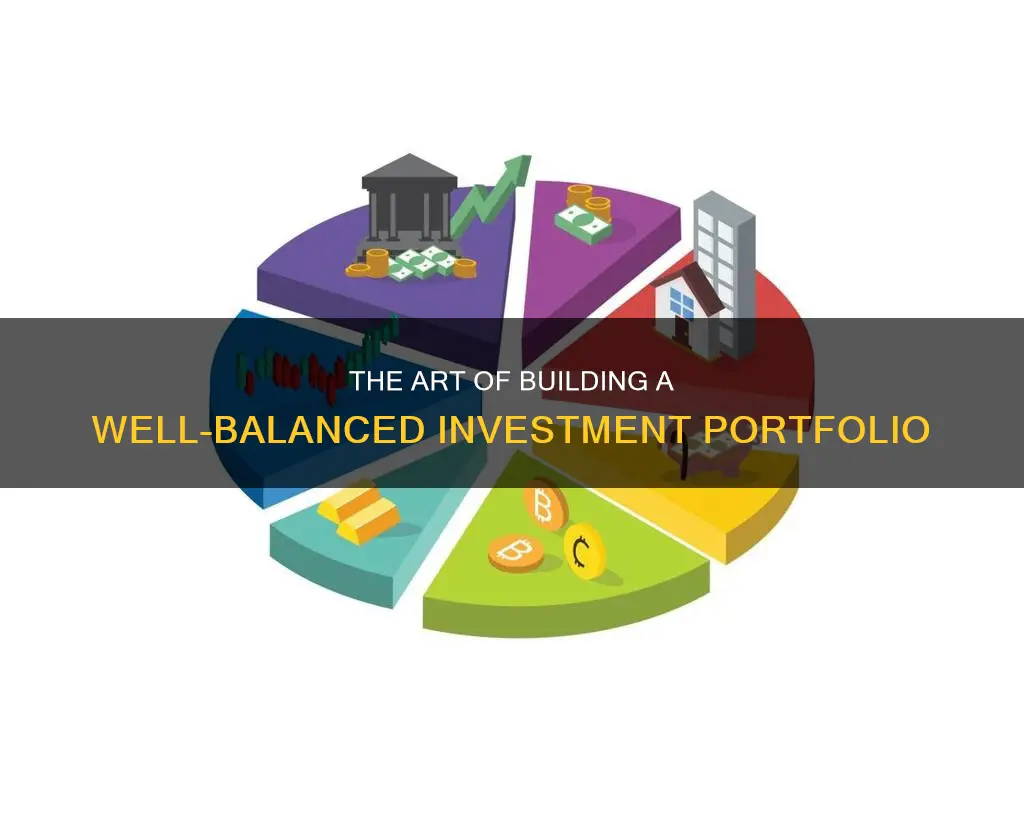
A well-balanced investment portfolio is essential to help you manage market risk and achieve your long-term goals. The best portfolio balance will fit your risk tolerance, goals, and evolving investment interests.
There are many different ways to put together a portfolio, depending on your preferences and risk tolerance. A good way to minimize risk is by creating a diversified and balanced portfolio with stocks, bonds, and cash that aligns with your short- and long-term goals.
Your portfolio balance will depend on your stage in life. For example, if you're in your 20s, you might want to invest aggressively, whereas if you're approaching retirement, you'll want to shift your portfolio toward more conservative investments.
To create a balanced portfolio, you should first understand your risk tolerance and set personal goals. Then, you can start choosing your investments and asset classes, which may include stocks, bonds, cash, commodities, equities, mutual funds, exchange-traded funds (ETFs), and money market accounts.
Remember to regularly rebalance your portfolio to ensure your investments continue to support your long-term goals without running unintended risks.
| Characteristics | Values |
|---|---|
| Risk tolerance | Depends on your life stage, financial situation, and investment goals |
| Investment goals | Depends on your life stage, financial situation, and risk tolerance |
| Investment types | Stocks, bonds, cash, real estate, commodities, mutual funds, exchange-traded funds (ETFs), money market accounts, certificates of deposit, savings accounts, etc. |
| Diversification | Divide your money among asset classes to reduce risk |
| Rebalancing | At least annually or after significant life events |
What You'll Learn

Understand your risk tolerance
Understanding your risk tolerance is a fundamental building block of long-term investment success. Your risk tolerance is the degree of risk that you are willing to endure given the volatility in the value of an investment. It is important to understand your risk tolerance as it will determine the type and amount of investments that you choose.
Your risk tolerance is influenced by several factors, including your age, investment goals, income, and future earning capacity. For example, younger investors with a longer time horizon are typically more risk-tolerant and may invest more in stocks and stock funds. On the other hand, older investors with a shorter time horizon may have a lower risk tolerance and prefer more stable and less volatile assets. Additionally, investors with a larger portfolio or more stable sources of funds may have a greater risk tolerance as they can afford to take on more risk without jeopardizing their financial stability.
It is important to assess your risk tolerance honestly and realistically. Many investment websites offer free online questionnaires and surveys to help you determine your risk tolerance. By understanding your risk tolerance, you can design a portfolio that reflects your tolerance level and benefits you in the long run.
Once you know your risk tolerance, you can start building a portfolio that aligns with your goals and risk appetite. A well-balanced portfolio typically consists of different percentages of bonds, commodities, equities, and other asset classes. If you have a low-risk tolerance, you may want to consider investing more in bonds and fixed-income assets. On the other hand, if you have a high-risk tolerance, you may want to allocate a higher percentage of your portfolio to equities and growth-oriented investments.
The User Conundrum: VCs' Magic Number for Investment
You may want to see also

Diversify your portfolio
Diversifying your portfolio is a crucial step in ensuring its balance and reducing risk. Diversification is a risk management strategy that involves spreading your investments across various assets, sectors, and markets. Here are some tips to help you diversify your portfolio effectively:
- Understand your risk tolerance: Before investing, it's important to assess your risk tolerance. This will help you determine the level of risk you are willing and able to take. Your risk tolerance will influence the types of assets you choose and the overall shape of your portfolio. For example, if you have a low-risk appetite, you may prefer more stable and predictable assets, whereas if you have a higher risk tolerance, you might opt for higher-risk assets with greater potential returns.
- Diversify across asset classes: A well-diversified portfolio typically includes a mix of stocks, bonds, cash, and other asset classes. Stocks, or equities, are riskier but offer higher potential returns, while bonds are generally considered safer but tend to generate lower returns. Cash and cash equivalents, such as savings accounts and certificates of deposit (CDs), are the lowest-risk and most liquid asset class. You can also consider investing in real estate, commodities, or alternative investments like hedge funds, private equity, or commodities.
- Diversify within asset classes: Diversification is not just about investing in different asset classes but also about diversifying within each class. For example, if you invest in stocks, consider investing in companies of different sizes and from different sectors and countries. Similarly, when investing in bonds, diversify by term and type, including government and corporate bonds.
- Consider mutual funds, exchange-traded funds (ETFs), and index funds: Investing in mutual funds, ETFs, or index funds is an easy way to create a diversified portfolio. These funds are typically invested in multiple securities, reducing the risk compared to investing in individual stocks.
- Rebalance your portfolio regularly: Markets fluctuate, and over time, your portfolio's balance may shift. Therefore, it's important to regularly rebalance your portfolio to ensure it aligns with your investment goals and risk tolerance. This may involve selling over-performing assets or investing more in under-represented asset classes.
- Seek professional advice: Building a diversified portfolio can be complex, and it's easy to become overwhelmed by the numerous options and considerations. Consider consulting a financial advisor or investment professional who can provide guidance based on your unique circumstances and goals.
Retirement Investing: Strategies for a Secure Future
You may want to see also

Determine your asset allocation
When determining your asset allocation, it's important to keep in mind that there is no one-size-fits-all approach to investing. The best portfolio balance will depend on your unique financial situation, goals, risk tolerance, and time horizon. Here are some key considerations to help you determine your asset allocation:
- Goals and Needs: Start by understanding your investment goals and needs. Are you investing for retirement, saving for a down payment on a house, or funding your child's education? Each goal will have different time horizons and capital requirements, which will impact your asset allocation.
- Risk Tolerance: Knowing your risk tolerance is crucial in determining your asset allocation. Are you comfortable with taking on more risk for potentially higher returns, or do you prefer a more conservative approach to preserve your capital? Your risk tolerance will influence the types of assets you choose and the overall shape of your portfolio.
- Time Horizon: Consider your investment time horizon, which is the amount of time you plan to hold your investments before needing the funds. If you're investing for the long term, you may be able to take on more risk. Conversely, if you have short-term goals, you may want to allocate more towards less risky assets.
- Diversification: Diversification is a risk management strategy that involves spreading your investments across different asset classes to reduce risk. Diversify across different types of assets, such as stocks, bonds, cash, real estate, and commodities. Diversification can help you manage systematic risks, such as wars, pandemics, or political turbulence, as well as non-systematic risks specific to a particular asset, company, or sector.
- Rebalancing: Markets fluctuate, and over time, the balance of your portfolio may shift. Regularly review and rebalance your portfolio to ensure it aligns with your investment goals, risk tolerance, and time horizon. This may involve selling over-performing assets or investing more in under-performing asset classes to maintain your desired allocation.
- Seek Professional Advice: Building a balanced portfolio can be complex, and it's easy to feel overwhelmed. Consider seeking advice from experienced financial advisors or investment professionals who can guide you in creating a portfolio tailored to your needs.
Remember, determining your asset allocation is a personal process that depends on your individual circumstances. It's important to regularly review and adjust your allocation as your goals, risk tolerance, and time horizon evolve over time.
Lucrative Investments Offering 3% Returns and Beyond
You may want to see also

Rebalance regularly
Over time, the balance of your portfolio will shift. Certain assets may outperform others, and you may become over-allocated in one asset class. For example, if your portfolio has a 60% allocation to stocks and 40% to bonds, you may become over-allocated to stocks if they outperform. Generally, stocks are considered riskier than bonds, so your portfolio may need to be rebalanced by selling stocks.
Rebalancing is the process of returning the values of a portfolio's asset allocations to the levels defined by an investment plan. Those levels are intended to match an investor's tolerance for risk and desire for reward. It is a disciplined, unemotional investment approach that can reduce exposure to risk. It can also be changed as investors' financial needs and investment goals change.
There are several types of strategies for rebalancing, such as calendar, constant-mix, and portfolio insurance. Calendar rebalancing involves analyzing and adjusting the investment holdings within the portfolio at predetermined times. Many long-term investors rebalance once a year, while other types of investors with different outlooks and goals may rebalance quarterly or even monthly. The ideal frequency of rebalancing must be determined based on an investor's time constraints, threshold for transaction costs, and allowance for value drift.
The constant-mix strategy is responsive but more costly to use than calendar rebalancing. Every asset class or individual security is given a target weight and a corresponding tolerance range. For example, an allocation strategy might include the requirement to hold 30% in emerging market equities, 30% in domestic blue chips, and 40% in government bonds, with a corridor of +/- 5% for each asset class.
Remember, portfolios are more likely to become unbalanced when markets are unpredictable. This is when the time spent setting your investment goals will pay off: remember your goals, stick to your strategy, and invest for the long term.
Uninvested: The Emotional Impact
You may want to see also

Consider your age and life stage
When building a well-balanced investment portfolio, it's important to consider your age and life stage. This will impact your risk tolerance, investment goals, and time horizon. Here are some tips to consider based on your age and life situation:
In Your 20s:
If you're in your 20s, now is the time to start investing aggressively, especially if you've graduated college without incurring significant debt. You can take advantage of compound interest by investing in stocks, growth stocks, or exchange-traded funds. Consider allocating a larger portion of your portfolio to stocks, as you have time to recover from market downturns. Automate your investments by setting up regular contributions to retirement accounts, such as a 401(k) or an individual retirement account (IRA).
In Your 30s and 40s:
As you enter your 30s and 40s, you may find that your tolerance for risk decreases. If you have children, it's important to start saving for their education while also prioritizing your retirement savings. Consider investing in tax-advantaged accounts like 529 plans for education and continue contributing to your retirement accounts. Diversify your portfolio by investing in stocks, bonds, and fixed-income assets to balance growth and risk.
Approaching Retirement:
When you're in your 50s and 60s, it's crucial to start planning for retirement if you haven't already. You may want to shift your portfolio towards more conservative investments, such as bonds, dividend-paying stocks, and other stable income-generating assets. Review your risk tolerance and investment goals, and consider assets that offer more liquidity and lower volatility.
During Retirement:
Once you retire, your focus should shift to preserving your capital and generating a steady income. Consider investing in low-risk, income-generating investments such as fixed-income securities and conservative dividend stocks. Along with your investment portfolio, don't forget to plan for estate and potential healthcare needs. Consider long-term care insurance and update your will and trusts.
Other Life Stages:
Life stages such as getting married, starting a family, or experiencing a career change can also impact your investment portfolio. For example, your investment goals and risk tolerance may differ if you're newly married or starting a family compared to a retired investor. It's important to periodically review and rebalance your portfolio to ensure it aligns with your life stage, risk tolerance, and investment goals.
Zack's Investment Recommendations: Current Insights
You may want to see also
Frequently asked questions
A balanced investment portfolio combines asset classes to balance risk and return. Typically, it is divided between stocks and bonds, with a small cash or money market component for liquidity purposes.
A balanced investment portfolio can help to protect your money against extreme losses when the market has its periodic swings. It can also help you manage market risk and achieve your long-term goals.
First, you need to understand your unique goals, timeframe, and capital requirements. Second, assess your risk tolerance. Third, determine your asset allocation. Fourth, diversify your portfolio. Finally, rebalance your portfolio regularly.
Examples of asset classes include stocks, bonds, cash, commodities, equities, mutual funds, exchange-traded funds (ETFs), and money market accounts.
Here are some tips:
- Don't rely on past performance as a guide to future returns.
- Diversify across and within different asset types.
- Get emotionally connected with your investments to stay engaged.







